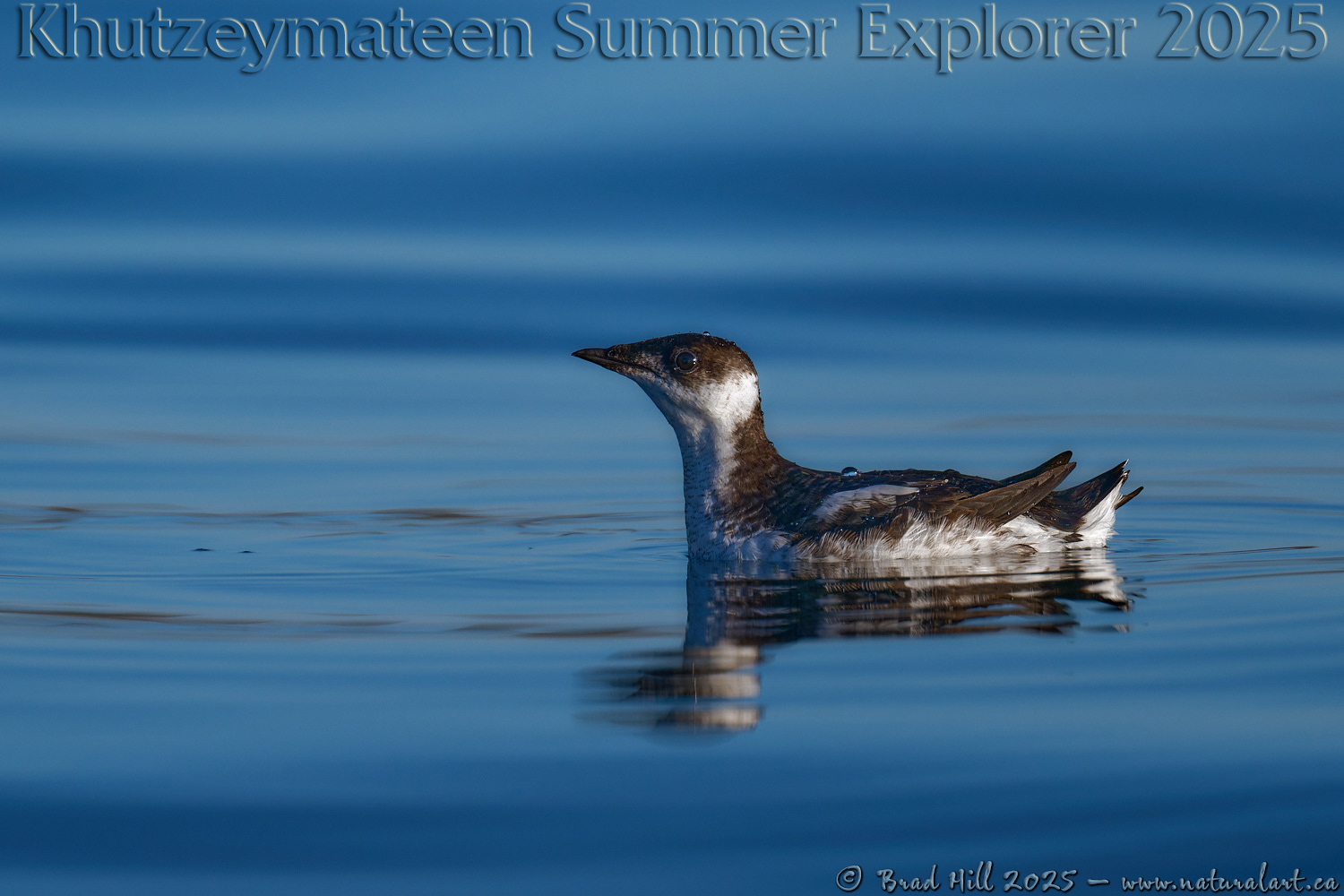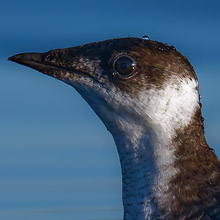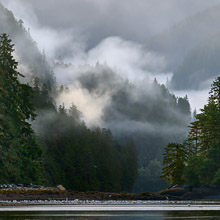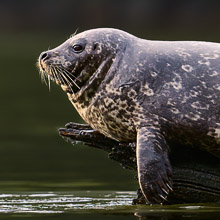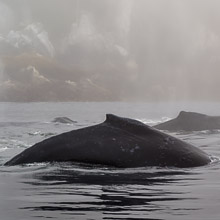Availability: Undetermined - Enquiries?
In the Field
Marbled Murrelet - The Enigma of the Pacific. Great Bear Rainforest, British Columbia, Canada. August 29, 2025.
If you've traveled along the coast of BC you may have encountered a very special - and threatened - little seabird, and you may have not even known it! The Marbled Murrelet's entire global range is along the Pacific coast of North America. This small and somewhat "chunking" looking seabird has been called the "Enigma of the Pacific' because of its secretive behaviour and mysterious nesting behaviour. In fact, it wasn't until the late 1970's that humans finally found their first Marbled Murrelet nest!
Why was it so hard to find their nests? Well...they fly VERY fast and don't head to their nests until it's almost dark out. And, uniquely among Alcids, they don't do the typical "nest on the ground on a remote island" thing - they nest on thick branches high in trees in old-growth forests, and often in trees deep in the forest. Plus, the nests are very inconspicuous - basically small depressions on a bed of moss (which tends to grow abundantly on thick boughs in the Great Bear Rainforest.
Unfortunately, these elusive little seabirds are now classified as threatened globally, and are critically endangered in some jurisdictions. Why? Well, the primary factor is the removal of old-growth forests (and thus the removal of nest-sites) over much of their current and former range. And as a seabird that relies on small bait fish (e.g., herring) they have also been hit hard by both gill nets and by the reduction in their food base. As a near-shore species they also are very vulnerable to oils spills - oiling causes not only direct mortality (through hypothermia) but also has sublethal physiological and reproductive consequences that affect local populations. As an example, at least 8,400 murrelets (mostly Marbled Murrelets) were killed in the Exxon Valdez oil spill in Prince William Sound.
Marbled Murrelets tend to be quite enigmatic to photographers as well. Like Kingfishers they have the uncanny ability to taunt and tease photographers...often floating on the surface of the water until just before coming into super-telephoto range - at which point they dive amazingly fast, only to resurface far beyond the range of even an 800mm lens! After seeing Marbled Murrelets during my BC coastal photo tours over the past two decades this is absolutely the best photo I have captured of one! Of course, there's a positive side to this - getting a classic photo of one gives me an ongoing goal and motivation to keep trying!
Here's a larger version (4800 pixel) of this enigmatic little seabird for your perusal:
• Marbled Murrelet - The Enigma of the Pacific: Download 4800 pixel image (JPEG: 3.0 MB)
ADDITIONAL NOTES:
1. These images - in all resolutions - are protected by copyright. I'm fine with personal uses of them (including use as desktop backgrounds or screensavers on your own computer), but unauthorized commercial use of the image is prohibited by law. Thanks in advance for respecting my copyright!
2. Like all photographs on this website, these images were captured following the strict ethical guidelines described in The Wildlife FIRST! Principles of Photographer Conduct. As such, no baiting or any form of attractant was used and, as always, we attempted to minimize our impact on the ongoing behaviour of the subjects. I strongly encourage all wildlife photographers to always put the welfare of their subjects above the value of their photographs.
3. This image was captured during my Khutzeymateen Summer Explorer Exploratory Photo Adventure in late summer of 2025. Each year I offer photo tours into various locations on the amazing BC coast, including the Great Bear Rainforest and, every other year, into the Khutzeymateen Grizzly Sanctuary (to photograph grizzlies, of course!). Details about these trips can be found on the Photo Tours page of this website.
Behind the Camera
Marbled Murrelet - The Enigma of the Pacific. Great Bear Rainforest, British Columbia, Canada. August 29, 2025.
High Efficiency* Compressed RAW (NEF) format; ISO 360.
Nikon Z 9 paired with Nikkor Z 800mm f6.3S. Hand-held from floating Zodiac. VR on in Sport mode. Wide-area custom (13x3) AF area mode with subject detection on "Birds" mode.
1/3200s @ f6.3; -1.0 stop compensation from matrix-metered exposure setting.
At the Computer
Marbled Murrelet - The Enigma of the Pacific. Great Bear Rainforest, British Columbia, Canada. August 29, 2025.
Initial noise reduction and capture sharpening on the .nef (raw) file using the DeepPRIME XD2S algorithm of DXO PhotoLab 9.2 Elite )using the lens/camera optical module of the Nikon Z9 + Nikkor Z 800mm f6.3S).
Subsequent adjustments to the adjusted linear DNG file (exported from PhotoLab) and conversion to 16-bit TIFF file (and JPEG files for web use) - including all global and selective adjustments - made using Capture One Pro (build 16.7). In the case of this image three global adjustments were made - an overall contrast bump using the Levels tool as well as tweaks to the highlights and to the blacks. Selective local adjustments performed using Capture One Pro's layers and masking tools. In this case numerous small adjustments and minor tweaks were made on 6 separate layers, with the tweaks being associated with "exposure balancing" and contrast adjustments (such as adjustments to brightness, clarity, highlights, shadows, blacks, etc.).
Photoshop modifications included insertion of the watermark and/or text.
Conservation
Marbled Murrelet - The Enigma of the Pacific. Great Bear Rainforest, British Columbia, Canada. August 29, 2025.
Species Status in Canada and the USA*: Listed as Threatened in Canada and BC under the Species At Risk Act (SARA). Listed as Threatened in Oregon, Washington, and California under federal Endangered Species Act and as Endangered by the state of California.
The Marbled Murrelet (Brachyramphus marmoratus) is a small member of the alcid family and is unique amongst alcids in nesting in trees. It often selects the largest trees in old-growth stands and places its nest on the top of the stout, moss-covered boughs.
The numbers and distribution of the Marbled Murrelet has declined dramatically over the past century primarily because logging and coastal development have removed its essential nesting habitat. Gill-net fishing and oil spills also have had an impact on these birds either by directly killing them or removing its prey.
*as determined by COSEWIC: The Committee on the Status of Endangered Wildlife in Canada













